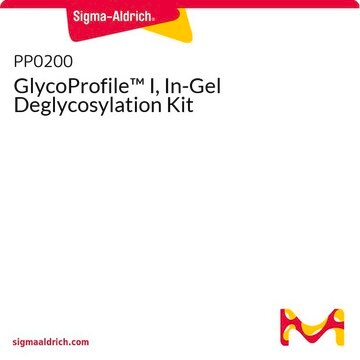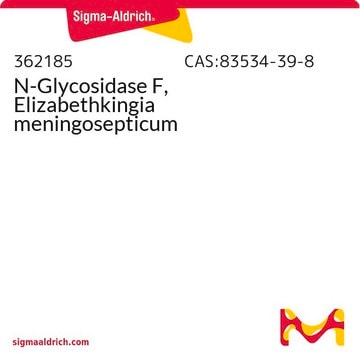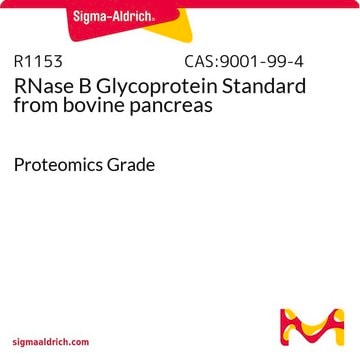P7367
PNGase F from Elizabethkingia meningoseptica
BioReagent, ≥95% (SDS-PAGE), for proteomics
Sinónimos:
PNGase F
About This Item
Productos recomendados
biological source
bacterial (Elizabethkingia meningoseptica)
Quality Level
conjugate
(N-linked)
grade
for proteomics
product line
BioReagent
assay
≥95% (SDS-PAGE)
form
powder
shelf life
≥1 weeks at 2‑8 °C (for a reconstituted solution >500 units/ml)
≥1 yr at 2‑8 °C
Solution is stable for at least 3 freeze-thaw cycles
mol wt
~36 kDa
concentration
≥300 units/mL
≥50 units/mL
optimum pH
~8.6
shipped in
wet ice
storage temp.
2-8°C
¿Está buscando productos similares? Visita Guía de comparación de productos
General description
Application
- for de-N-glycosylation of Zika20virus E protein
- to evaluate coxsackievirus and adenovirus receptor glycosylation using CAR-expressing COS cells
- to verify the N-linked glycosylation of MHC class 1 polypeptide-related sequence A (MICA)
Biochem/physiol Actions
Unit Definition
related product
signalword
Danger
hcodes
pcodes
Hazard Classifications
Resp. Sens. 1
Storage Class
13 - Non Combustible Solids
wgk_germany
WGK 2
flash_point_f
Not applicable
flash_point_c
Not applicable
ppe
Eyeshields, Gloves, type N95 (US)
Certificados de análisis (COA)
Busque Certificados de análisis (COA) introduciendo el número de lote del producto. Los números de lote se encuentran en la etiqueta del producto después de las palabras «Lot» o «Batch»
¿Ya tiene este producto?
Encuentre la documentación para los productos que ha comprado recientemente en la Biblioteca de documentos.
Los clientes también vieron
Artículos
Protein modifications are crucial for disease study. Analysis methods are key.
Explore strategies for releasing N-linked glycans with PNGase F, PNGase A & native & sequential deglycosylation with endoglycosidases & exoglycosidases.
Protocolos
Explore mass spectrometry analysis of glycans for glycomic & glycoproteomic neutral & acidic glycan analysis. See a general mass spec glycan analysis procedure.
Nuestro equipo de científicos tiene experiencia en todas las áreas de investigación: Ciencias de la vida, Ciencia de los materiales, Síntesis química, Cromatografía, Analítica y muchas otras.
Póngase en contacto con el Servicio técnico









